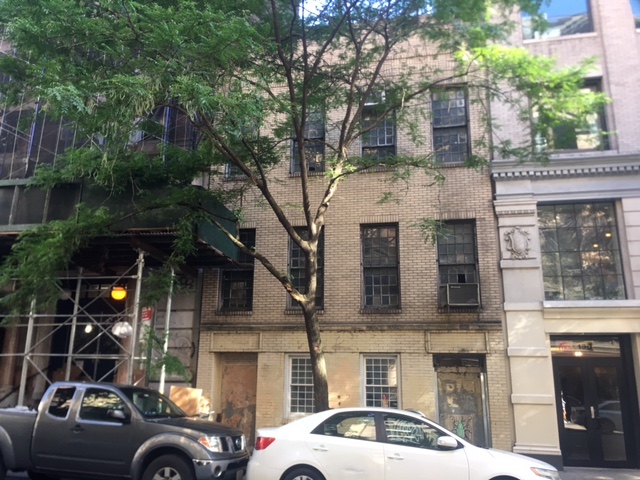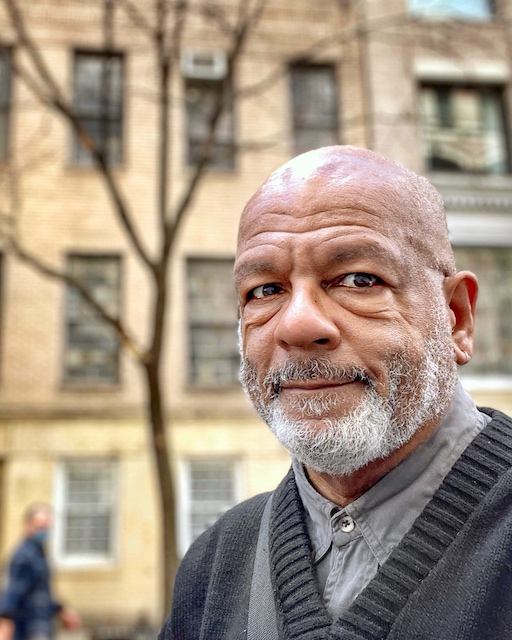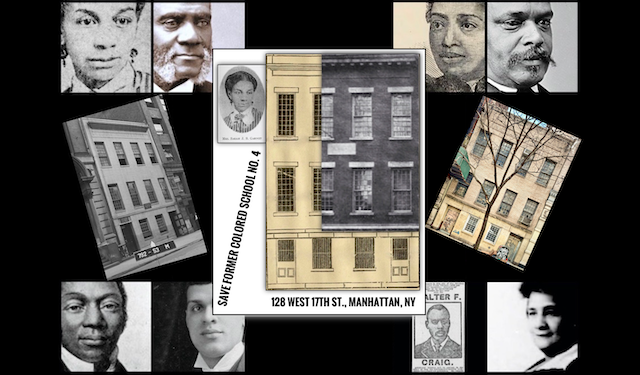
BY SCOTT STIFFLER | Steeped in a history few who pass by its doors are aware of, the role in African American history played by a building on the 100 block of West 17 Street compels New York City to grant it landmark status.
That’s the rallying cry of author, black New Yorker, licensed NYC tour guide, and recently minted preservationist Eric K. Washington, whose quest to landmark the structure at 128 West 17th Street (btw. 6th & 7th Aves.) has the support of elected officials, historians, community groups, and—by indications thus far—NYC’s Landmarks Preservation Commission (LPC), the department with the power to determine the fate of former Colored School No. 4.
Washington first brought the three-story building to public attention in 2018, during the course of research conducted for his acclaimed biography Boss of the Grips: The Life of James H. Williams and the Red Caps of Grand Central Terminal (Liveright/W.W. Norton, 2019). Williams was among the students who passed through its doors from 1860 to 1894, when it served as a segregated public school for African Americans. Initially, it provided education to students ranging from approximately four to 14 years of age. Later, the school would add classes for adults, often welcoming the parents, even grandparents of its grammar and primary grade students (Washington found records of students in their 70s).
“Its graduates and teachers were the progenitors of myriad citizen leaders who would effectively build the community of Harlem, even farther Uptown, into the renowned 20th-century capital of Black America,” says Washington, in an online petition he created to demonstrate a diverse support base for his landmarking efforts. (Click here to add your name to the petition, which had 982 signatures at the time this article was published.)
Among the notables (or yet to be notables) who spent time at Colored School No. 4 are, says Washington, Rev. J.W.C. Pennington—abolitionist, orator, minister, writer, and educator; Oscar James Dunn—the first Black Lieutenant Governor of Louisiana; Henry Ossian Flipper— the first Black graduate from West Point; and S. Elizabeth Frazier—the first Black teacher in mixed NYC public school.
Then there is Sarah J.S. “Tompkins” Garnet, whose mettle was tested early on in her 31 years as the school’s principal. “When a racist white mob set upon the schoolhouse during New York’s infamous Draft Riots of July 1863,” said Washington, she “supervised her teachers in barring all the doors, and later even led many of the children to their homes before making her own way home to Brooklyn.”
With documentation including the abovementioned luminaries and a dozen other students and staff who became high achievers in politics, the performing arts, and education, Washington took the first step required by LPC to landmark a building. In November of 2018, an RFE (Request for Evaluation) was submitted to support Washington’s contention that “woefully too few sites” granted landmark status “reflect the complex historical trajectory, milestones and breadth of the African American experience in our great city.”
Washington notes that his request is not without precedence: In 1998, the LPC landmarked Brooklyn’s Colored School No. 3, thought to be that borough’s only such surviving structure. Still, although Washington resubmitted his RFE in 2021 with new evidence, he’s received “no substantive updates” from LPC in three years. (At least when words were exchanged, they were good ones: LPC said the storied structure “may merit consideration for designation.”)

Washington says with much of the pandemic era’s gridlock ebbing or at least easing, it’s time to put this project back on the LPC’s front burner. A growing number of others agree. To date, the quest to landmark Colored School No. 4 has the backing of neighboring block associations, historical societies, agencies, and individuals who’ve appealed to the LPC in writing to, as Washington says on his petition’s web page, “expedite the unduly pending evaluation of this unheralded heritage site… and actualize the rightful designation of the former Colored School No. 4 building as an individual cultural landmark.”
On November 1, 2021—after two unanimous votes in favor by the Chelsea Land Use (CLU) committee of Manhattan Community Board 4 (CB4) and the board’s full membership—a letter sent to LPC Commissioner Sarah Carroll recommended the structure be “designated a Landmark of historical and cultural significance.” Among their reasons: Its distinction as the “only remaining ‘Colored School’ in Manhattan” and its current state as a property owned, but not used, by the NYC Department of Sanitation (DOS).
In lock step with Washington’s own desire for the building’s future use, CB4 suggested the space “could be an excellent learning environment for New York City’s children and families to understand the heritage and migratory path of black residents over the centuries. It could illustrate the segregated policies in the city’s educational system in the 1800’s while providing examples of African Americans who made important contributions to the society.”
Furthermore, noted CB4, the property’s repurposing would see it join “other nearby sites that tell important stories of local Black history,” such as West 29th Street’s Lamartine Place Historic District, home to Manhattan’s only documented Underground Railroad stop, and West 53rd Street’s St. Benedict the Moor Church. Established in 1898, it served as the first Black Roman Catholic Church north of the Mason Dixon line and, CB4’s letter noted, “reflects the days when Clinton/Hell’s Kitchen was a thriving African American neighborhood.” (CB4 submitted their own RFE in hopes of landmarking the church.)
Kerry Keenan, who began serving as Co-Chair of the Chelsea Land Use committee earlier this year, was among the CB4 members in attendance at a May 23, 2022 online meeting that brought together reps from DOS, Eric K. Washington, and District 3 City Councilmember Erik Bottcher. A vocal supporter of landmarking, Bottcher’s January 23, 2022 letter to LPC’s Carroll, asked her to “designate this site as soon as possible for its architectural significance, its place in African American history, and its place in the history of public education in New York City. “
In a phone interview the week after that meeting, Keenan recalled its convivial tone, with all in attendance aligned to the notion that a return to form for Colored School No. 4 was appropriate. Specific to CB4’s position, noted Keenan, “This is part of a larger effort to champion and celebrate” African American history in the board’s area of coverage. “We cannot let an opportunity like this slip through our fingers,” noted Keenan, who said that with the exception of some minor roof damage they’d like to see repaired as soon as possible, the building is “remarkably intact, which is important to LPC, and when you have the owners [DOS] on board for landmarking [as they’ve indicated], it’s a much stronger case.
Responding to an email, LPC Director of Communications Zodet Negrón told Chelsea Community News that 128 W. 17th St. is “currently within the portfolio of DSNY [DOS], and therefore is already owned by the City of New York. We do extensive outreach with property owners [including City agencies] with the goal of gaining their support for designation and understanding of our regulatory process.”

Negrón was also able to confirm LPC receive both Washington’s 2018 RFE on November 16 of that year “as well as his follow-up request on April 2, 2021, as an amendment to his original submission. In LPC’s initial review of the RFE, the agency determined that the property may merit consideration for designation.”
The information Williams shared, said Negrón, was added to survey files containing their own research. As such, she noted, “We have prioritized further research and evaluation of the building and have been continuing that work.” Asked about the impact of word of solidarity sent in writing by supporters including the Municipal Arts Society, Save Chelsea, the Council of Chelsea Block Associations, and others, LPC noted they’ve “received and carefully reviewed these letters, many of which provided important information and helpful insights that contribute to our own research.”
LPC was less specific when asked to ballpark a date for the on-record procedural discussions that give momentum to the landmarking process, noting such Commission-led initiatives are scheduled “based on agency priorities. We assess potentially meritorious properties in light of many factors, including historical, architectural and/or cultural significance, integrity to a period of significance, the agency’s policy of designating resources in all five boroughs, and the importance of the resource in the context of similar and/or already designated resources.”
CB4’s Keenan, in her phone interview with Chelsea Community News, noted the case for landmarking seems strengthened given the January, 2019 launch of LPC’s Equity Framework, which Negrón said ensures “diversity and inclusion in designations, with a particular focus on preserving historic places associated with underrepresented communities to better tell the story of all New Yorkers.” Thus far, their study of Colored School No. 4 and its association with 19th century African American history,’ noted Negrón, “fits within this framework.”
Chelsea Community News is made possible with the help of our awesome advertisers, and the support of our readers. If you like what you see, please consider taking part in our GoFundMe campaign (click here). To make a direct donation, give feedback, or send a Letter to the Editor, email scott@chelseacommunitynews.com.

Pingback: This Week In & Around Chelsea: March 18-24, 2024 - Chelsea Community News
Pingback: On Landmark Designation Day, $6 Million Pledged to Preserve Chelsea’s (Former) Colored School No. 4 - Chelsea Community News
Pingback: April 25 Hearing Gives the Public Their Say in Landmark Designation for (Former) Colored School No. 4 - Chelsea Community News
Pingback: Calendaring Sets Stage for Landmarking of Former ‘Colored School No. 4’ Site – Chelsea Community News
Pingback: Landmarking Advocates: Damage from Roof Runoff Requires Rapid Repair – Chelsea Community News